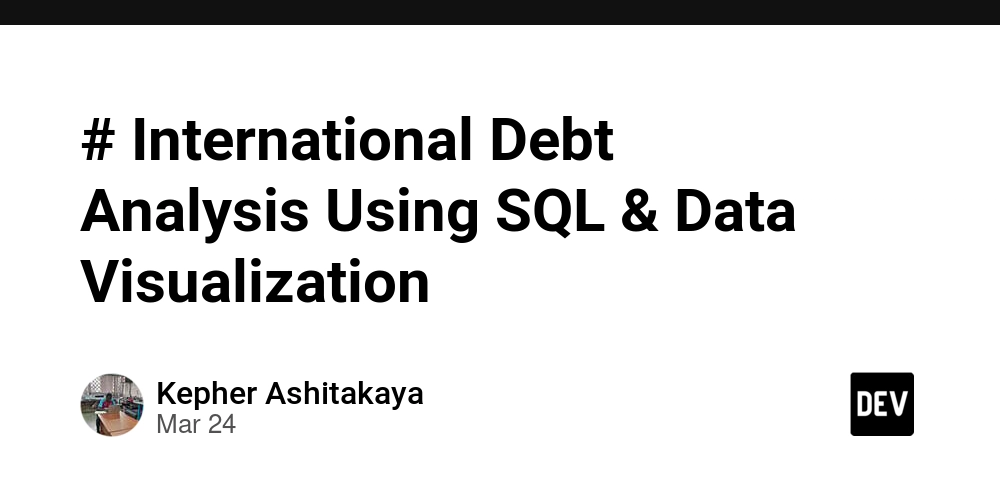# International Debt Analysis Using SQL & Data Visualization
INTRODUCTION This project analyzes the World Bank Data set on debts acquired by developing countries from the years 1970 to 2015. The debt accrued is grouped into multiple debt categories. This documentation aims to bring an understanding of the debt data to be able to provide accurate and reliable financial insights for impactful decision making. Insightful Questions What is the total amount of debt owed by the countries? Here we use the aggregate function of SUM(debt) to calculate the total amount of debt owed by the countries. How many distinct countries are recorded in the dataset? Here we use the DISTINCT keyword to get only the country names without having multiple country names. What are the distinct types of debt indicators, and what do they represent? This requires the unique debt indicators from the dataset and what they mean. We use the DISTINCT indicator_name to get the unique debt indicator names. What do they represent: PPG – Public and Publicly Guaranteed debt (this is debt borrowed by the government or debt that the government has guaranteed). PNG – Private Non-Guaranteed debt (this is debt borrowed by private entities without government backing). AMT – Principal Amount (the original loan amount that must be repaid). Example: If a country borrows $1 million, repaying $200,000 of that original amount is a principal repayment. INT – Interest Payment (the extra cost paid to borrow money). If a country borrows $1 million at 5% interest, they pay $50,000 in interest annually. DIS – Disbursement (the money actually received from the lender). Example: If a lender approves $500,000, but only $300,000 has been received so far, that's the disbursement. -External Debt – Debt borrowed from foreign lenders (not domestic). Types of Lenders: Multilateral – Large international organizations like the World Bank or IMF. Bilateral – Loans from one country to another. Commercial Banks – Traditional banks that lend money. Private Creditors – Non-bank lenders such as investment funds or private institutions. Official Creditors – Government-related institutions or international development organizations. Other Private Creditors – Smaller private lenders that don’t fit in typical categories. The Country with the highest debt and by how much? -Use of MAX(debt) aggregate function to find the maximum debt, selecting also the country name and grouping the country name since we have the second column of country name we then use LIMIT 1 to filter only the top country. What is the average debt across different debt indicators? This question we group the debt based on the debt indicators and we then calculate the average amount of debt using the AVG(debt) aggregation function. Which country has made the highest amount of principal repayments?

INTRODUCTION
This project analyzes the World Bank Data set on debts acquired by developing countries from the years 1970 to 2015. The debt accrued is grouped into multiple debt categories. This documentation aims to bring an understanding of the debt data to be able to provide accurate and reliable financial insights for impactful decision making.
Insightful Questions
- What is the total amount of debt owed by the countries?
- Here we use the aggregate function of SUM(debt) to calculate the total amount of debt owed by the countries.
- How many distinct countries are recorded in the dataset?
- Here we use the DISTINCT keyword to get only the country names without having multiple country names.
-
What are the distinct types of debt indicators, and what do they represent?
- This requires the unique debt indicators from the dataset and what they mean. We use the DISTINCT indicator_name to get the unique debt indicator names. What do they represent:
- PPG – Public and Publicly Guaranteed debt (this is debt borrowed by the government or debt that the government has guaranteed).
- PNG – Private Non-Guaranteed debt (this is debt borrowed by private entities without government backing).
- AMT – Principal Amount (the original loan amount that must be repaid). Example: If a country borrows $1 million, repaying $200,000 of that original amount is a principal repayment.
- INT – Interest Payment (the extra cost paid to borrow money). If a country borrows $1 million at 5% interest, they pay $50,000 in interest annually.
- DIS – Disbursement (the money actually received from the lender). Example: If a lender approves $500,000, but only $300,000 has been received so far, that's the disbursement. -External Debt – Debt borrowed from foreign lenders (not domestic). Types of Lenders: Multilateral – Large international organizations like the World Bank or IMF. Bilateral – Loans from one country to another. Commercial Banks – Traditional banks that lend money. Private Creditors – Non-bank lenders such as investment funds or private institutions. Official Creditors – Government-related institutions or international development organizations. Other Private Creditors – Smaller private lenders that don’t fit in typical categories.
The Country with the highest debt and by how much?
-Use of MAX(debt) aggregate function to find the maximum debt, selecting also the country name and grouping the country name since we have the second column of country name we then use LIMIT 1 to filter only the top country.-
What is the average debt across different debt indicators?
- This question we group the debt based on the debt indicators and we then calculate the average amount of debt using the AVG(debt) aggregation function.
-
Which country has made the highest amount of principal repayments?













































































































































































![[The AI Show Episode 142]: ChatGPT’s New Image Generator, Studio Ghibli Craze and Backlash, Gemini 2.5, OpenAI Academy, 4o Updates, Vibe Marketing & xAI Acquires X](https://www.marketingaiinstitute.com/hubfs/ep%20142%20cover.png)


























































































































![[FREE EBOOKS] The Kubernetes Bible, The Ultimate Linux Shell Scripting Guide & Four More Best Selling Titles](https://www.javacodegeeks.com/wp-content/uploads/2012/12/jcg-logo.jpg)



![From drop-out to software architect with Jason Lengstorf [Podcast #167]](https://cdn.hashnode.com/res/hashnode/image/upload/v1743796461357/f3d19cd7-e6f5-4d7c-8bfc-eb974bc8da68.png?#)






































































































.png?#)





.jpg?#)































_Christophe_Coat_Alamy.jpg?#)








































































































![Rapidus in Talks With Apple as It Accelerates Toward 2nm Chip Production [Report]](https://www.iclarified.com/images/news/96937/96937/96937-640.jpg)







































































































































